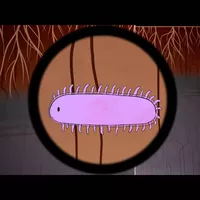The Hidden Perils of Permafrost | Deep Look
It may not look like it, but underneath all this Arctic snow is a potential climate change catastrophe.
This is permafrost... soil that stays frozen all year round.
And you can see, inside, how it's packed with minerals, decaying plants and ice.
Researchers from Lawrence Berkeley National Lab and other institutions are pulling permafrost cores like this one out of the ground in Barrow, Alaska.
Permafrost covers nearly a quarter of the land mass in the Northern Hemisphere and all those dead plants amount to a huge amount of carbon trapped in the soil.
It's almost 200 times what we, humans, pump into the atmosphere each year.
So what happens to all that carbon if a warming climate causes the permafrost to thaw?
Scientists are throwing every conceivable piece of scientific hardware at one small patch of permafrost, to study it in incredible detail.
They want to know exactly what's buried inside, how much ice, what kinds of materials and bacteria, and how will it all react as global temperatures continue to rise.
They're repurposing a CT scanner, an instrument normally used to diagnose disease in people.
We're traveling down the length of the corе, starting with the part closest to the surface.
This is called the active layer.
It thaws every spring and then freezes again in the fall.
Now we're moving into the actual permafrost.
This soil may have been frozen for ten thousand years or longer.
So what if that starts to change?
When permafrost thaws, the bacteria inside spring to life [and] they start eating the dead plants.
And as they eat, they release greenhouse gases — like carbon dioxide and methane — that trap heat in the atmosphere.
And what worries scientists is that, as the climate warms, more and more of the permafrost will thaw.
Carbon that's been locked in the soil for millennia may be released in a very short amount of time trapping more heat in the atmosphere.
This could be a catastrophic feedback loop.
But it could be more complicated than that…
What if the extra carbon dioxide makes more plants grow at the surface, and the extra plants actually absorb some of that carbon released when the permafrost thaws?
This sounds like a subtle distinction, but it could have a huge impact on the fate of our planet.
The goal of this research is to know what we're headed for.
Some of the answers may lie in this chunk of icy earth.

